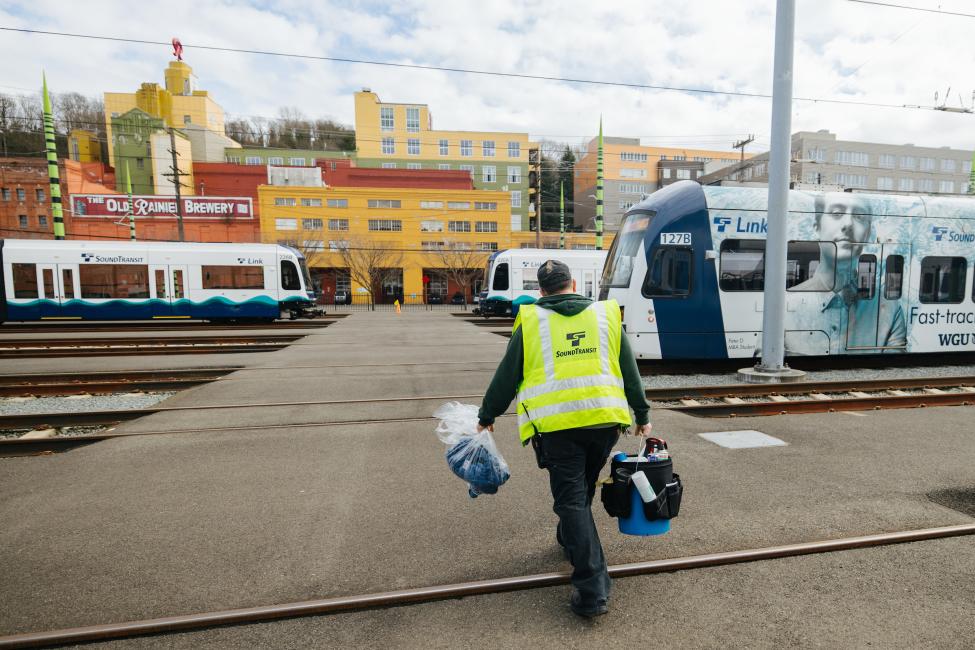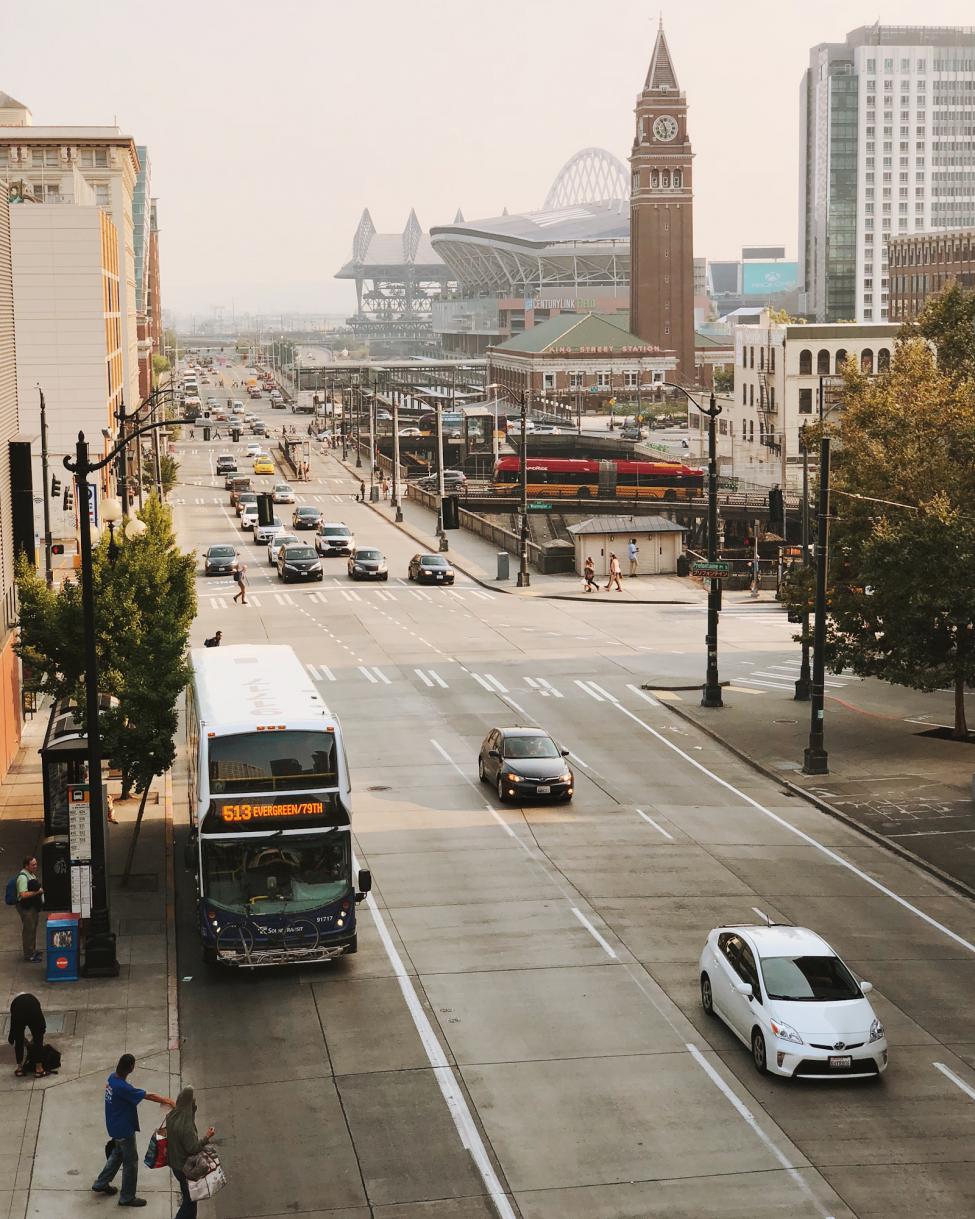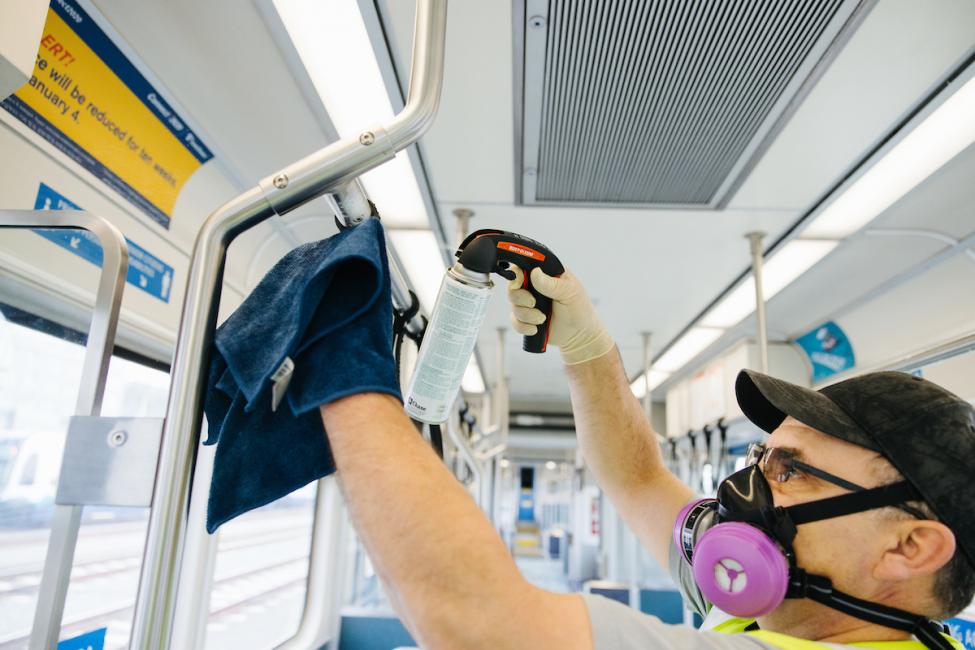David Wright is Sound Transit’s Chief Safety Officer
Since the pandemic, our transit operators and passengers alike have increasingly sounded the alarm about illegal substance use happening on Sound Transit’s trains and buses.
Sadly, we’re not alone; public drug use is an issue communities and transit agencies are grappling with across our region and nationwide.
These anecdotal reports have spurred a lot of questions. How much drug residue is actually present inside transit vehicles? Could secondhand smoke harm an operator driving 40+ hours a week? What about a passenger who rides a few minutes per day? How can transit agencies better protect the public?
No data existed to begin answering those questions, until today.
Researchers at the University of Washington have published the results of a first-in-the-nation study, commissioned by Sound Transit and four other transit agencies from across the Pacific Northwest.
The bottom line? Our region’s public transit vehicles are safe—and we can do more to make them even safer.
“It’s important to have studies like this one from the University of Washington to help identify when there are new substances that may be circulating in our indoor environments,” said Dr. Faisal Khan, Director of Public Health – Seattle & King County. “When someone uses fentanyl or methamphetamine, the concentration of leftover drug in the air is minimal. Therefore, secondhand exposure to low levels of residue in the air is unlikely to lead to negative health effects.”
Work is already underway at the five agencies that commissioned the study (Sound Transit, King County Metro, Community Transit, Everett Transit, and Portland’s TriMet), on several health and safety improvements recommended in the report.
These recommendations—which include things like air filter upgrades and enhanced cleaning protocols, as well as increased training and mental health support for employees—may also set new best practices for other transit agencies across the country.
What the researchers found
The UW researchers took samples from vehicles owned by four of the five participating transit agencies.
Based on previous operator and rider reports of onboard drug use, these four agencies identified routes and times where these substances were most likely to appear, and the researchers set out to collect samples from 11 buses and 19 train cars over 28 nights, between March 27 and June 22, 2023.
They sampled both the air and surfaces inside the vehicles, at or near the operators’ positions and in other areas where smoke is likely to accumulate.
Of 78 total* air samples tested:
-
20 (25%) had detectable fentanyl
-
78 (100%) had detectable methamphetamine
Of 102 total* surface samples tested:
-
47 (46%) had detectable fentanyl
-
100 (98%) had detectable methamphetamine
*The samples evaluated weren’t identified by agency name in the study.
The report emphasized that “[d]etection of fentanyl or methamphetamine by the lab does not necessarily mean it was detected at a level that poses a health risk to operators or the riding public.”
To put these amounts in context, Dr. Robert G. Hendrickson, Medical Director of the Oregon Poison Center, used a sugar packet analogy.
“The highest concentration of fentanyl in a wipe sample was 0.728 ng/cm2,” Dr. Hendrickson said. “A cm2 is about the size of your fingerprint. So, how much fentanyl would be on your fingertip if you touched the highest contaminated area of a train? About a nanogram, which is a billionth of a gram. Imagine a small white packet of granulated sugar—that is about 2-4 grams. So, pour that out and isolate one crystal of sugar—that is about 20 milligrams. If you were to take one 20 millionth of that sugar crystal, you would have a nanogram, and that is the amount that would be on your fingertip.”
In fact, public health officials say the contaminant amounts researchers found do not represent a health threat to passengers, and riders do not need to change their current habits.
Read a joint statement by the Washington and Oregon Poison Centers here.
“Transit is a critical service, and equitable access to safe transportation is part of a healthy community. We understand that the detection of fentanyl and methamphetamine in these spaces is concerning,” said Snohomish County Health Officer Dr. James Lewis. “Available evidence and knowledge about the chemistry of these substances indicate that the risk to the public from secondhand exposure is low, and we will continue to monitor as our knowledge base grows.”
There are currently no state or federal regulations specific to airborne or surface levels of methamphetamine or fentanyl occurring in the workplace. The best guidance at present comes from the U.S. Environmental Protection Agency, which has issued a health-based occupational exposure guideline for airborne fentanyl.
Of the 78 air samples UW researchers collected:
-
One exceeded the EPA guideline for fentanyl in the air (0.1 μg/m3). “This is a health-based guideline, meaning keeping average work shift airborne exposures to fentanyl below this value is considered to be protective of chronic health outcomes for workers, such as transit operators,” the report noted.
There is no similar health-based guideline or state or federal regulation for airborne methamphetamine. The Washington State Department of Health has established a decontamination standard for surfaces, though.
Of the 102 surface samples collected:
-
Two exceeded the DOH decontamination guideline established for methamphetamine (15 ng/cm2). “This is a health-based standard, therefore cleaning surfaces to be below this level should protect both operator and rider health,” the report explained.
How we’re using the science
Safety is one of Sound Transit’s six official values, but it’s also our highest priority as a transit agency.
We’re keenly aware of our passengers’ and operators’ concerns around potential exposures to drug smoke on our vehicles, and that’s exactly why we sponsored this research—to get clear and actionable information to address those concerns.
Here’s what you can expect from Sound Transit in the months ahead:
Improved ventilation on vehicles
Even before Sound Transit commissioned this study, we’d already started working to upgrade filtration on our Link light rail cars and ST Express buses. In light of concerns around the increasing wildfire smoke and virus variants our region has faced in recent years, we’ve prioritized upgrading to filters with a minimum efficiency reporting value (MERV) rating of 13 wherever possible.
To better protect against airborne concentrations of drug smoke and its byproducts, the UW report likewise recommended the MERV 13 standard. MERV 13 filters can capture smaller particles than lower-rated ones, including smoke and other byproducts.
Upgrading a transit fleet to MERV 13 isn’t as simple as popping new filters in tomorrow, though. In some cases, higher-rated filters simply don’t fit. In others, vehicles’ HVAC systems aren’t engineered to handle a higher-rated filter, and using them could end up decreasing air flow overall or even damaging the system. That means filtration upgrades can require extensive hardware retrofits.
While most of our buses are already using MERV 13 filters, our Link cars currently use MERV 10 filters. As recommended by the report, we’ll continue filtration upgrades wherever possible to reach “as high of a MERV filter rating as feasible.”
More frequent and enhanced cleaning protocols
We rely on our operating partner King County Metro (KCM) for daily maintenance on our Link light rail vehicles and many of our ST Express buses.
KCM recently piloted enhanced cleaning practices at two of their bus bases, and initial studies indicate they’ve been highly effective at reducing drug residue to the lowest possible levels.
Those bus cleaning practices will expand to all seven KCM bases and include upgrading from dry sweeping to vacuums equipped with a high-efficiency particulate air (HEPA) filter and implementing a detergent-based deep cleaning of buses every 10-14 days. Daily wipe-downs of high-touch areas and the driver’s area also will continue.
Sound Transit will continue to work with KCM to expand that program onto light rail vehicles, and with our other bus operating partners Community Transit and Pierce Transit to enhance cleaning protocols.
Removing offenders from transit
Smoking and illegal substance use are prohibited on transit, plain and simple. Security personnel will immediately remove anyone smoking on trains in violation of Washington’s transit code of conduct.
Our goal is to ensure these interactions are handled appropriately and with compassion, in a way that ensures that people can be directed to needed resources while also ensuring the safety for everyone else onboard.
“The safety of our staff, our riders, and our community is always our highest priority,” said Sound Transit CEO Julie Timm. “While this is the underlying motivation for Sound Transit’s commissioning of this study last year, it is also the reason why we did not wait to increase our security presence and to start pilot partnerships with support services on our system earlier this year.”
Sound Transit currently employs more than 55 officers from the King County Sheriff’s Office, with a budget to grow to over 90 officers. We also average more than 250 transit security officers on our system weekly, based on new contracts executed in spring 2023.
With this new level of support, Sound Transit security began removing people using drugs on vehicles and encouraging all riders to call or text security when they witness violations. We’ve since seen a positive decline in rider complaints and reports of this behavior on the system.
By consistently stepping up our efforts to reduce incidents and improve air quality and cleaning protocols, we expect to reduce these contaminants to undetectable levels.
This landmark study is just a starting point. We’re grateful to the UW research team for their work to execute this work, helping transit agencies like ours develop data-informed strategies to keep our passengers and workforce safe.


